|
SHE WILL ONLY BRING YOU HAPPINESS
OutRun 2 - seven days later.
One of the most disappointing things about videogame reviews, both online and in print mags, is their shallowness. The average gamer buys just somewhere between two and 10 games in a year, and hence each one has to last a long time. The average reviewer will be expected to play perhaps 100 games a year to a professional level (unless they work for Official Xbox Magazine, of course, in which case they can just read the press releases), in addition to anything they might play solely for fun. This leaves a huge gap between the gamer's and the reviewer's perceptions of gaming as a whole, but that's another article.
But a reviewer's necessarily short attention span also conflicts with their supposed purpose as a buyer's guide. If you're a reviewer, a game that provides a short burst of intense pleasure may well generate an extremely positive review, which might be at odds with the sort of experience that the consumer handing over £40 in a game shop is expecting for their money. So with that in mind, your OutRun 2-loving reporter decided to take another look at the game after a week of concentrated play that resulted in the game being all but completed, with every significant feature unlocked. We'll start... now.
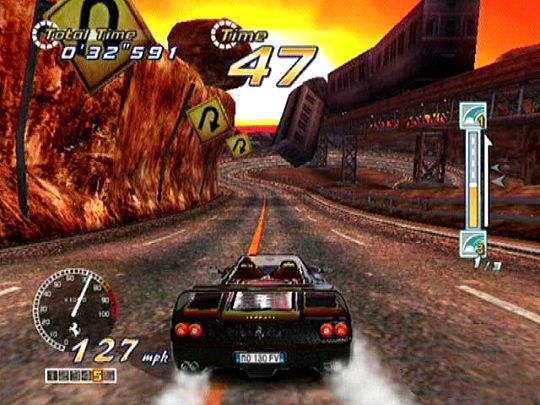
There's clearly been a terrible catastrophe in this bonus stage. The race should really be stopped.
First, it's probably worth mentioning what the best of those features (all unlocked by completing six-mission stages in the OutRun Challenge mode) are. Fairly early on you'll get a fully-playable version of the original 1986 OutRun. Your reviewer's seen people criticise this as a poor port, but such comments seem to be based on a rose-tinted memory of the coin-op. Checking it against the real thing in MAME reveals that OR2's depiction of its parent game is in fact more or less flawless.
Secondly, you'll reveal two "Bonus Stages", which comprise courses made up from the tracks of two unconverted Sega coin-ops, Scud Race and Daytona USA 2. (In both cases, the arcade game's Beginner, Normal and Expert tracks are all joined together to form one continuous stage with checkpoints providing the linking sections.) These are both visually stunning, but the dramatic scenery gives the Xbox more problems than the normal OR2 stages, and framerate stutter is - while still pretty minor - noticeably more pronounced on the Bonus Stages than in the game proper.
More importantly, the tracks simply aren't nearly as well designed as the normal OR2 ones, with some cheap tricks and tediously technical sections and little opportunity for OR2's trademark drifting, and in the final analysis simply aren't very much fun to play. In fact, what they do most successfully is illustrate with great clarity this difference in the core philosophies of OutRun 2 and most other racing games. (The Daytona 2 course, incidentally, comes off quite a lot worse than the Scud Race one both in framerate and design terms. It's easy to see why it wasn't in the same league of success as its coin-op predecessor.)
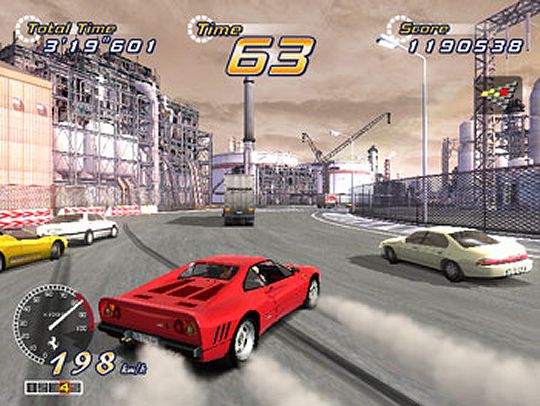
The surprisingly picturesque Industrial Complex stage.
Apart from the bonus tracks and the original coin-op, most of OutRun 2's unlockable secrets aren't that exciting. You get a bunch of extra music (three "Euro Remix" versions of the three classic OutRun tunes - which turned out to be your reviewer's racing soundtrack of choice - plus the original 1986 versions, and a few variants on OR2's rather poor all-new music tracks); reversed versions of all the game's stages to race in Time Trial or Rival Race modes; some pretty insignificant new cars which aren't noticeably different from the ones you have at the start; and finally the Special Stages, which we'll get to in just a moment.
It's all the more remarkable, then, that OutRun 2 kept an iron grip on this reviewer's attention all week. Every morning, quick ten-minute sessions turned into three-hour marathons, and the reason is that - as touched on in the original review - this game is simply such a joy to play entirely for its own sake that the rather disappointing nature of most of your rewards becomes an irrelevance. Nowhere is this better demonstrated than in the Special Stages (also known as the Endurance races), so let's talk about those.
Unlocked one at a time when you've completed a full "branch" of stages in the Challenge mode, the five Special Stages are simple point-to-point races between you and a single opponent. The course is packed with other traffic, but the only important thing is to finish in front of your opponent at the end. (It's also possible to lose by failing to make a checkpoint within the time limit, but you'd have to drive very badly indeed to blow it that way.) The Special Stage from the easiest branch of the OutRun 2 world (that is, the tracks you'd get by taking the left turn at every checkpoint in Arcade mode) is 10 stages long, and each of the other four branches adds five stages to that, so the last Endurance race is a monstrous 30 stages long (ie all 15 of the normal game's tracks in both normal and reversed variations).

The scenery is so lovely, you wonder why everyone's driving out of it so fast, all in one direction.
Now, you might be thinking that that sounds like a pretty gruelling prospect. And when you factor in the knowledge that OutRun 2 adopts the Mario Kart model of opponent AI (which is to say, artificially slowing the car in the lead/speeding up the one behind so that the gap between them is always kept fairly small), it appears to be a recipe for disaster. Because what could be more soul-crushingly awful than to lead your opponent through 29 stages, crash right at the end, and see them whip past you over the line because the game had unfairly handicapped you for being in the lead, right?
Nobody's more surprised than your correspondent to report that in fact, this isn't the case. There are two reasons for this flouting of all the known laws of good game design, and one of them is the previously-observed point that OutRun 2 is so enjoyable that even if you lose at the end of a 30-minute race, those 30 minutes were so much fun that it doesn't really matter that you lost. The second reason is a lot more important, and it's this: OR2 plays fair.
The handicapping rules are the same for your opponent as they are for you, and what's more, your opponent is as fallible as you are - they're prone to bumping into the other traffic, getting stuck behind it, taking the wrong line on corners and all the same mistakes you're likely to make. What this does is give your opponents believable "character" - even when you're trailing, you can see them up ahead making a hamfisted mess of an easy drift or getting blocked behind a couple of lorries - which makes the Special Stages feel closer to jousting with another human being than any CPU racer has yet achieved. Even when you're as far back as it's possible to be, you never lose hope, and that makes for a compelling race.
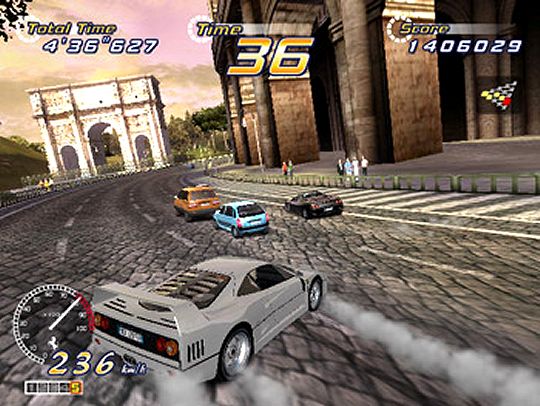
There's actually no need to slide on this particular bend. He's just showing off.
Conversely, the game deals from a straight deck even while you're in front and it's holding you back, though. The in-race ranking system provides you with three "levels" of lead (denoted "A", "AA" and "AAA"), which it alerts you to with excellent use of distinctive audio cues, so you can tell - without taking your eyes off the road for a second - if you've stretched your lead or whether your opponent's catching up. If you build up an "AAA" lead, you'll probably be able to survive a fairly hefty shunt and still stay in front, but "A" means your rival's right on your tail, so you can judge how riskily you need to tackle every corner. Even with handicapping, then, it's always worth getting ahead and building your lead.
The rival's position is also highlighted by their name appearing above their car or, if they're behind you, in its horizontal position on the track. What this means is that if you've had a bump and are going slowly, you can still try to block your opponent's overtaking manoeuvre, using the other traffic to help if there's any around. Similarly, if you're trailing, the name shows you where the rival is and how far ahead (you can judge this by the horizontal movement showing you what bends they're taking) they are, even if you can't see their car.
All this is still-further indication of just how much the designers of OutRun 2 want you to enjoy playing their game. It's constructed in such a way as to remove every last possible interface or control obstacle, everything that might possibly get in the way of the purity of the race. The result is that even if you do screw up on the last stage of an Endurance race (as your reporter did repeatedly on one particular one, having completed the other four first time), you've got no excuse. You weren't cheated. You cocked it up, it's your fault, you should have driven better. And because it's so much fun (see also the murderous, but scrupulously fair, brutality of the likes of Challenge Mission 15.6, which alert viewers should start preparing themselves for now), you don't mind in the slightest having to do it all again, because it's just another chance to enjoy yourself.
(The pill is also sweetened by the fact that there's nothing at stake, unlockables-wise, in the Special Stages - all you get for them is a new little cutscene at the end. Plus there are different ones if you lose, so you'll want to fail each Special Stage at least once anyway.)
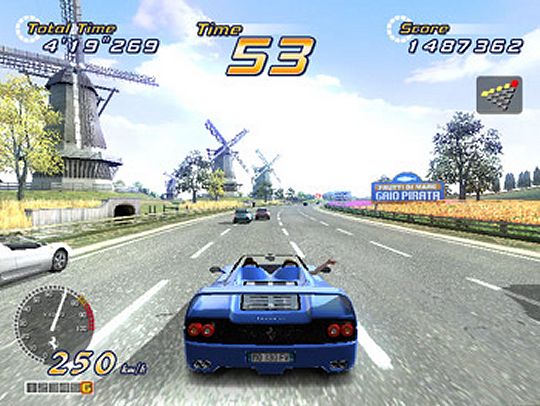
Sadly, unlike in the first OutRun, you can't plough through the tulip fields in the Dutch stage.
The truth of the matter, dear viewers, is that your reviewer's post-review week of OutRun 2 revealed mostly flaws. You'll see the large majority of OR2's good points (as well as most of the good unlockables) in your first two days of play, and even though a lot has been added to the arcade game to extend its life for home play, most of the obvious newness is on the surface. After the early discovery of OutRun '86 and the Scud Race/Daytona 2 tracks, there are no more playable games hidden away, and no more new courses. Once you've beaten all 101 missions of OutRun Challenge (for which, as far as this reporter can ascertain, you get no special reward at all), there's only Time Trial mode, Heart Attack highscores in Arcade, and better ratings in the individual missions left to aim for.
(Although at the moment your correspondent's status screen only shows 121 of the 142 Challenge cards unlocked, with five of the "Reward" cards - the ones that actually give you new features - still to play for. The trouble is that there's no visible indication of what the conditions to unlock the last 22 cards are - the last one unlocked by your intrepid reviewer came from upgrading an "AA" rating on an innocuous first-level challenge to an "AAA". Getting the triple-A rating on some of the challenges requires literally flawless driving, and this reporter doesn't fancy trying to improve his current feeble total of 17 hard-won AAAs to a terrifyingly daunting 121 in order to hunt for those elusive last five Reward cards.)
But - and here's the underlying theme of our two-part epic reviewathon, which we've found ourselves touching on again and again over the last few thousand words - none of the little flaws or missed opportunities in OutRun 2 make the slightest dent in its incredible powers of entertainment and joy. This reporter hasn't enjoyed a videogame so much for so long since Grand Theft Auto 3, and if the odd hiccup here and there reminds us that life isn't perfect, well, that'll only save us some crushing disillusionment later.

Unrealistically, the back of the bus isn't full of little kids pulling faces and waving.
In many ways it's hard to think of a game further removed from GTA3's sandbox ethos than OutRun 2 - this is pure arcade-style gaming, set within rigid, highly artificial frameworks and bereft of any kind of realism other than the graphical one. (Any sense of cohesive reality in the game world is dispersed when, in various challenge-mode missions, the tracks are placed in completely different orders to the original layout, with reversed ones stuck in the middle of forwards ones and allsorts.) The cars' handling is absurd, the physics crazy, you can't turn around, there's no oncoming traffic ever (every road on OutRun Island appears to be a one-way street - how does anyone ever get home?), entire roadfuls of cars simply disintegrate in front of your eyes in certain challenge modes... and yet, this is gaming every bit as pure as GTA3, albeit in a superficially different way.
But what GTA3 and OR2 share is one of the core qualities common to all great games - a structural invisibility. Each game's universe - just like Super Mario 64's or Goldeneye's, say - makes sense on its own terms, and within moments of picking the controller up, the mechanical interface between the game and the player effectively disappears - the sparse, elegant front-ends are so unintrusive that your brain can just shut them out. (Here, again, we have to point an accusing comparative finger at the likes of Burnout 3, whose loading times and unnatural arrangement of "Yes/No" defaults makes simple actions like quitting and restarting a stage a hazardous, time-consuming chore which never fails to remind the player he's playing a videogame rather than driving an insanely fast car through a lethally violent destruction derby. And there are immeasurably worse offenders in the world of games than that, bizarrely even including some from the same company that brought us OutRun 2.)
For every minute you spend with a truly great game, 59 seconds will be occupied not with negotiating menus or wrestling with stupid control layouts, but with doing the thing that the game's supposed to be about. And when your subject matter is as seductive as OutRun 2's, that can only be a beautiful thing. One week on, that elemental truth hasn't changed a bit.
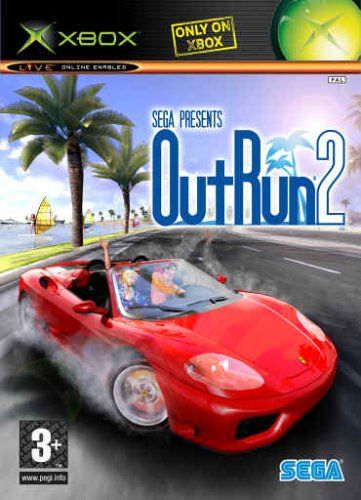
OutRun 2 is/was released for the Xbox on 1 October 2004, RRP $40/£40/€55. |

